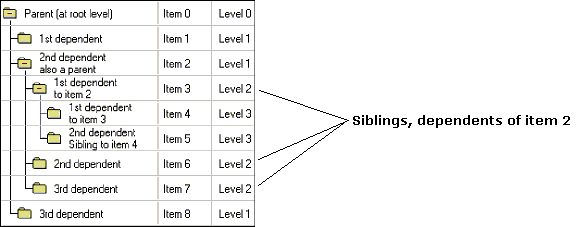Items
Items within tree controls have relationships to other items based on the level they are on. This determines how items are connected to each other. The following table defines the terms used throughout to identify relationships and the connecting lines drawn for each type:

The following table defines the terms used throughout to identify relationships and the connecting lines drawn for each type:
| Term | Description |
|---|
| A is an item which has a parent. The item is said to be a of the . can be themselves or . A cannot be at the . The Item.FirstDependent and Item.LastDependent properties can be used to retrieve item information for an item. |
| The indicates whether items are visible or not. A that has one or more visible is considered expanded. If a is expanded, all its immediate , i.e., all on the next lower level are visible. If a is collapsed, no immediate are visible. The Item.Expanded property can be used to determine the current of an item. Items can be expanded and collapsed using the Item.Expand and Item.Collapse methods. An item can be marked expandable using the Item.Expandable property, even if it has no child items. |
| A is an item which has no , i.e., it is not a . may have and . |
| Parent | A can be located at any level. In order to become a , an item has to have one or more , which are items that immediately follow the and are on a lower level. A may be expanded and collapsed using the Item.Expand and Item.Collapse methods. Expanding a means making its immediate ( on the next lower level) visible. Collapsing a means hiding all its (on all lower levels). may have and . An item can be marked expandable using the Item.Expandable property, even if it has no child items. The Item.Parent property returns an item's parent index. |
| Any item without parent is at the , usually level 0. Multiple items can be at the , or . The Item.Level property can be used to retrieve an item's level number. |
| A is an item which precedes or follows another item on the same level with the same parent. An item can have zero or more items. items can be parent and . The Item.FirstSibling, Item.NextSibling, Item.PrevSibling, Item.LastSibling properties can be used to retrieve information about an item. |
| A is a (or top level parent) if it has no parent of its own. Top may have items. The Item.TopParent property can be used to retrieve the topmost . |
| The indicates whether an item is visible or not. An item is considered visible if its immediate and all other are expanded. An item is considered visible even if it isn't currently displayed in the window client area. The Item.Shown property can be used to define an item's . |
When adding items to a tree control, all that is required from an application is that the level numbers be set. The SftTree/OCX tree control automatically determines the correct relationships and draws connecting lines appropriately. Applications can then interrogate the tree control about relationships and don't have to manage these themselves.

